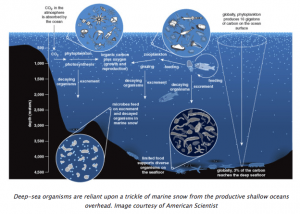
Wouldn’t it be nice if our meals, snacks, and beverages just fell from the sky right into our hands as if it were rain or snow? What if those Skittle’s commercials where little, fruity candies rained down from vibrant rainbows above your head were actually a reality? Come on, admit it; at one point in your life, you wished that skittles would trickle on down on top of your head and waterfall right into your mouth and hands. Instead of rain, what if it was drops of Coca-Cola or orange juice? What a life it would be….I guess?
 Well in our reality, rain is still cumulated water particles from the sky that get pulled down by gravity, rainbows are a distant visual spectacle that always disappear just when you are about to get close them, and our food still hides out in the pantry and refrigerator, lifeless and alluringly calling our names to indulge. So then what’s the point of all this talk about food-borne weather phenomena? Well, lets take a dive down to the very depths of the ocean to find out.
Well in our reality, rain is still cumulated water particles from the sky that get pulled down by gravity, rainbows are a distant visual spectacle that always disappear just when you are about to get close them, and our food still hides out in the pantry and refrigerator, lifeless and alluringly calling our names to indulge. So then what’s the point of all this talk about food-borne weather phenomena? Well, lets take a dive down to the very depths of the ocean to find out.
While food falling from the sky may not be our reality, it is for the Deep Sea believe it or not! Communities of mysterious deep dwelling organisms actually obtain a majority of their diet from what falls from “the sky” (or the open water above, rather). This descending, nutritious organic matter is more formally named, Marine Snow.
More clearly, marine snow is showering organic material that falls from the surface above down towards the bottom of the ocean. It originates from dead animals, plants, plant-like organisms, such as algae, and even fecal matter. Some of it even comes from inorganic matter, such as sand, silt, and other related materials. Mass contributors of the falling snow typically come from plankton feasted on by bigger consumers. Fish, invertebrates, marine mammals, and even zooplankton are examples of these predatory individuals. As the dead, decaying matter descends from the upper layers of the ocean, they fuse together and accumulate into larger “snow-like” particles. As these particles slowly make there way down, deep sea organisms that aren’t so lucky to find food on a frequent basis filter out the snow to obtain vital nutrients, like carbon and nitrogen, needed for optimal survival. What ever is left continues to fall slowly until it is either consumed by other deep dwelling creatures or it makes impact with the ocean floor. The time is takes for marine snow to typically reach the bottom is around two weeks. Overtime, marine snow that doesn’t get eaten will slowly start to accumulate on the sea floor forming “oozy” mounds of decomposed matter. These mounds will, in turn, become food for detritus buried within the floor or get sifted up by deep-sea conveyor currents that eventually work there way to the surface.
Marine snow additionally poses as a major carbon sink on our oceans. As mentioned above, these particles are rich in carbon and other organic nutrients. The left over material that contributes to the bottom mound of organic ooze is highly composed of that carbon, which will sit and stay rested until it gets sifted up within the deep-sea currents and transported back to the surface where it can return to the ocean’s food web and to our atmosphere.
Before you allow yourself to get bitter over the fact that it snows practically everyday within the ocean than it does on land, just know that 1). it ain’t the white, fresh, powdery goodness that falls from our sky during the winter months, and 2). it’s a natural life process that feeds the hunger that resides in the deepest part of our oceans and regulated the excessive amounts of carbon that hang out in our atmosphere and oceans. Now how cool is that?
Written by: John Cornett
Photo Links
Marine Snow Diagram – http://www.deepseanews.com/2011/12/let-it-snow-let-it-snow-let-it-snow/


